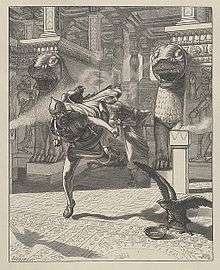Arda-Mulissu
Arda-Mulissu or Arda-Mulissi (Akkadian: Arda-Mulišši[1]), also known as Urad-Mullissu and Arad-Ninlil and known in Hebrew writings as Adrammelech, was an ancient Assyrian prince of the Sargonid dynasty, the son of the Assyrian king Sennacherib and the older brother of Sennacherib's successor Esarhaddon. Arda-Mulissu had served as Sennacherib's crown prince and heir for several years, since the death of Sennacherib's first crown prince Ashur-nadin-shumi in 694 BC, but was for unknown reasons replaced as heir by Esarhaddon in 684 BC.

Disappointed by this, Arda-Mulissu was the chief orchestrator of a 681 BC conspiracy in which he and one of his younger brothers, Nabu-shar-usur, murdered Sennacherib in the hopes of seizing the throne. Sennacherib's murder turned some of Arda-Mulissu's supporters against him and his coronation was postponed. In the turmoil that followed, Esarhaddon marched on the Assyrian capital of Nineveh and successfully seized the throne. After their failure, Arda-Mulissu and Nabu-shar-usur fled to the Kingdom of Urartu in the north after which their fate is uncertain.
Biography

Arda-Mulissu was the son of Sennacherib, who reigned as king of the Neo-Assyrian Empire from 705 BC to 681 BC. In 700 BC, Sennacherib had appointed his eldest son, Ashur-nadin-shumi, as the crown prince (designated heir) and gave him rule of Babylonia, which covered the southern Mesopotamian provinces of his empire.[2] Shortly after this appointment, Sennacherib campaigned against Elam (modern day southern Iran) to chase after Chaldean rebels which had fled there. In response to this incursion into their territory, the Elamites invaded the southern parts of the Neo-Assyrian Empire and in 694 BC successfully captured Ashur-nadin-shumi at the city of Sippar. The prince was taken back to Elam and probably executed.[3]
Needing to appoint a new heir from among his sons, Sennacherib then elevated his second eldest surviving son, Arda-Mulissu, as crown prince. Although Arda-Mulissu held the position of heir apparent for several years, he was replaced as heir by his younger brother Esarhaddon in 684 BC. The reason for Arda-Mulissu's sudden dismissal from the prominent position is unknown, but it is clear from contemporary inscriptions that he was very disappointed.[4] Despite his dismissal, Arda-Mulissu remained popular and some vassals secretly supported him as the heir to throne.[5]
Arda-Mulissu was forced to swear loyalty to Esarhaddon by his father, but repeatedly tried to appeal Sennacherib to again accept him as heir instead.[4] Sennacherib noted the increasing popularity of Arda-Mulissu and came to fear for his designated successor, so sent Esarhaddon away to the western provinces. This exile of Esarhaddon put Arda-Mulissu in a difficult position as he had reached the height of his popularity but was powerless to act with Esarhaddon away. In order to use the opportunity, Arda-Mulissu decided that he needed to act quickly and take the throne by force.[5]
Arda-Mulissu concluded a "treaty of rebellion" with another of his younger brothers, Nabu-shar-usur, and on 20 October 681 BC, they attacked and killed their father in one of Nineveh's (the capital of Assyria during their time) temples. Despite their conspiracy succeeding, Arda-Mulissu couldn't successfully seize the throne. The murder of the king caused some resentment against Arda-Mulissu by his own supporters which delayed his potential coronation. In the meantime, Esarhaddon had raised an army.[4] The army raised by Arda-Mulissu and Nabu-shar-usur met Esarhaddon's forces at Hanigalbat, a city in the western parts of the empire. There, most of their soldiers deserted and joined Esarhaddon, who then marched on Nineveh without opposition.[6]
Arda-Mulissu and Nabu-shar-usur fled to the Kingdom of Urartu in the north, an old rival of Assyria, and Esarhaddon successfully took the throne six weeks after Sennacherib's death. Shortly after taking the throne, Esarhaddon made sure to execute all conspirators and political enemies he could get his hands on, including the families of Arda-Mulissu and Nabu-shar-usur.[2][4] The eventual fate of Arda-Mulissu and Nabu-shar-usur is unknown, but they continued to live as exiles in Urartu for several years. Some inscriptions suggest that they were alive and free in Urartu as late as 673 BC.[7]
Legacy
The murder of Sennacherib, ruler of the mightiest empire on the planet at his time, was shocking to his contemporaries and was received with strong emotion and mixed feelings throughout Mesopotamia and the rest of the Ancient Near East. In the Levant and in Babylonia the news were celebrated and proclaimed as divine punishment due to Sennacherib's brutal campaigns against these regions while in Assyria, the reaction was probably resentment and horror. The event was recorded in numerous sources and is even mentioned in the Bible (2 Kings 19:37; Isaiah 37:38), wherein Arda-Mulissu is called Adrammelech.[5]
References
- Baker 2016, p. 272.
- Mark 2014.
- Bertman 2005, p. 79.
- Radner 2003, p. 166.
- Parpola 1980.
- Encyclopaedia Britannica.
- Barcina Pérez 2016, p. 9–10.
Cited bibliography
- Baker, Robin (2016). Hollow Men, Strange Women: Riddles, Codes and Otherness in the Book of Judges. BRILL. ISBN 978-9004322660.
- Barcina Pérez, Cristina (2012). "Display Practices in the Neo-Assyrian Period". Universiteit Leiden - Research Master in Assyriology.
- Bertman, Stephen (2005). Handbook to Life in Ancient Mesopotamia. OUP USA. ISBN 978-0195183641.
- Radner, Karen (2003). "The Trials of Esarhaddon: The Conspiracy of 670 BC". ISIMU: Revista sobre Oriente Próximo y Egipto en la antigüedad. Universidad Autónoma de Madrid. 6: 165–183.
Cited web sources
- "Esarhaddon". Encyclopaedia Britannica. Retrieved 22 November 2019.
- Mark, Joshua J. (2014). "Esarhaddon". Ancient History Encyclopedia. Retrieved 23 November 2019.
- Parpola, Simo (1980). "The Murderer of Sennacherib". Gateways to Babylon. Retrieved 14 December 2019.